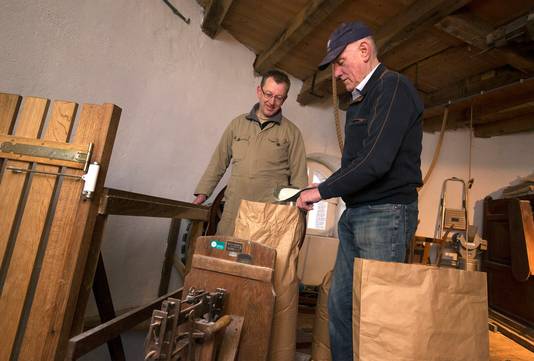The vanes of 'De 'Engel' mill are turning again in Varsseveld
See older post of repairs that were started when we were there in November
Windmill restoration, November 30th, 2018.
The vanes of mill De Engel turn safely again
VARSSEVELD - Mill de Engel in Varsseveld is fully operational again. Wicks and mills turn again and grind grain for home bakers and other enthusiasts. The windmill stood still for a year and a half because of a safety problem with the blades.
That has now been remedied, to the relief of miller André Konink, who, with the volunteer millers, keeps the monument from 1849 running. Every Saturday visitors are welcome and the vanes turn when the wind cooperates. "In the period that the mill stopped, we grinded corn on a small scale with an electric motor, so regular customers could get flour here. But if the blades do not turn, you will not get a lot of visitors, and that is a shame for our volunteers, "says Konink.
Issue
The problem arose when new insights at the National Service for Cultural Heritage about maintenance and sustainability did not work out well, say Konink and the volunteer millers Bartjan Kaptein and Henk Grevers. Traditionally, the blades consist of two beams, the rods. Each rod is provided with two blades. The total length of a rod, the flight, is slightly more than 24 meters at De Engel.
There was something wrong with the construction.
From the Government Service came the green light for a new method, with two pieces of 12-meter rod that had to be linked together. That was easier for transport and more sustainable. ,, In the restoration in 2010, this was also the case here '', say the millers."It could last 50 years." "
That was a miscalculation. In March 2017, all mills were stopped with this construction. "At two mills in the west of the country, bolts were broken in the metal part that connected the two halves with 24 bolts. Something was wrong with that construction. "
That was also the conclusion of mill builder Vaags from Aalten, who had made new calculations. "The standards of the Rijksdienst were based on a rigid connection, but that did not appear to be the case. It was more of a hinge due to the changing forces. As a result bolts in the coupling piece could fail, "says Konink.
That was a miscalculation. In March 2017, all mills were stopped with this construction. "At two mills in the west of the country, bolts were broken in the metal part that connected the two halves with 24 bolts. Something was wrong with that construction. "
That was also the conclusion of mill builder Vaags from Aalten, who had made new calculations. "The standards of the Rijksdienst were based on a rigid connection, but that did not appear to be the case. It was more of a hinge due to the changing forces. As a result bolts in the coupling piece could fail, "says Konink.
Danger
That danger was played by 48 windmills, of which De Engel was one.By connecting the two halves with the welding of a new piece the problem was solved. At De Engel new rods of 28 meters were installed, more reliable and almost as expensive. At the end of November the Varsseveld mill was next. Other repairs were also carried out.
"There are only a few mill builders in our country, we were on a waiting list," says Grevers. ,, For us it's hobby, millers who have to live from it went ahead. ''
The Engel grinds smaller amounts of rye, wheat or spelled. For sale and to allow visitors to see the mill in operation. In addition, people who grow grain themselves want to grind it to windmills.
The first floor of the mill is a small museum, including materials and tools from the local mill builder Willem Kreeftenberg, the builder of De Engel. Much of the past has been collected. And there the coupling piece with the 24 bolts, removed before it could become dangerous, is permanently added.
"There are only a few mill builders in our country, we were on a waiting list," says Grevers. ,, For us it's hobby, millers who have to live from it went ahead. ''
The Engel grinds smaller amounts of rye, wheat or spelled. For sale and to allow visitors to see the mill in operation. In addition, people who grow grain themselves want to grind it to windmills.
The first floor of the mill is a small museum, including materials and tools from the local mill builder Willem Kreeftenberg, the builder of De Engel. Much of the past has been collected. And there the coupling piece with the 24 bolts, removed before it could become dangerous, is permanently added.



Comments
Post a Comment